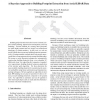Free Online Productivity Tools
i2Speak
i2Symbol
i2OCR
iTex2Img
iWeb2Print
iWeb2Shot
i2Type
iPdf2Split
iPdf2Merge
i2Bopomofo
i2Arabic
i2Style
i2Image
i2PDF
iLatex2Rtf
Sci2ools
3DPVT
2006
IEEE
2006
IEEE
A Bayesian Approach to Building Footprint Extraction from Aerial LIDAR Data
Building footprints have been shown to be extremely useful in urban planning, infrastructure development, and roof modeling. Current methods for creating these footprints are often highly manual and rely largely on architectural blueprints or skilled modelers. In this work we will use aerial LIDAR data to generate building footprints automatically. Existing automatic methods have been mostly unsuccessful due to large amounts of noise around building edges. We present a novel Bayesian technique for automatically constructing building footprints from a pre-classified LIDAR point cloud. Our algorithm first computes a boundederror approximate building footprint using an application of the shortest path algorithm. We then determine the most probable building footprint by maximizing the posterior probability using linear optimization and simulated annealing techniques. We have applied our algorithm to more than 300 buildings in our data set and observe that we obtain accurate building foo...
3DPVT 2006 | Accurate Building Footprints | Applied Computing | Approximate Building Footprint | Building Footprints |
| Added | 10 Jun 2010 |
| Updated | 10 Jun 2010 |
| Type | Conference |
| Year | 2006 |
| Where | 3DPVT |
| Authors | Oliver Wang, Suresh K. Lodha, David P. Helmbold |
Comments (0)

